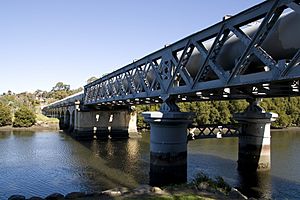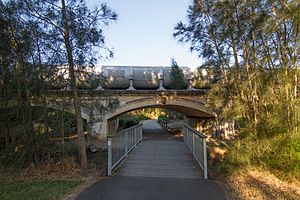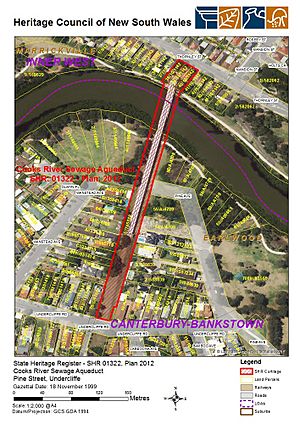Cooks River Sewage Aqueduct facts for kids
Quick facts for kids Cooks River Sewage Aqueduct |
|
|---|---|

Cooks River Sewage Aqueduct, looking from Marrickville to Earlwood, 2007
|
|
| Location | Pine Street, Undercliffe, City of Canterbury-Bankstown, New South Wales, Australia |
| Built | 1895 |
| Architect |
|
| Owner | Sydney Water |
| Official name: Cooks River Sewage Aqueduct | |
| Type | State heritage (built) |
| Designated | 18 November 1999 |
| Reference no. | 1322 |
| Type | Sewage Aqueduct |
| Category | Utilities - Sewerage |
| Builders | J.F. Carson, contractor |
| Lua error in Module:Location_map at line 420: attempt to index field 'wikibase' (a nil value). | |
The Cooks River Sewage Aqueduct is a special bridge in Sydney, Australia. It carries sewage pipes across the Cooks River between Earlwood and Marrickville. It was built in 1895. This amazing structure was designed by the Sewerage Construction Branch and the NSW Department of Public Works. It was built by J. F. Carson. The aqueduct is now owned by Sydney Water. It is considered a very important historical site. It was added to the New South Wales State Heritage Register in 1999.
Contents
A Bridge for Waste: The History of the Cooks River Aqueduct
Why Was the Aqueduct Built?
The Cooks River sewage aqueduct was finished in 1895. It was a key part of a big project called the Main Western Carrier. This project helped carry sewage from Sydney's western suburbs. The goal was to move waste safely away from homes.
The NSW Public Works Department designed the aqueduct. Robert Hickson was the main engineer at that time. The Main Western Carrier stretched from Rockdale to Marrickville. It needed many bridges and tunnels.
How Was It Built?
J. F. Carson was the builder for the aqueducts. The original plan included three large iron pipes. These pipes were supported by 17 brick arches. Each arch was about 32 feet (9.8 meters) wide. There were also two steel bridges, each 80 feet (24 meters) long. The total length of the aqueduct is about 720 feet (220 meters).
The steel bridges have strong metal frames called lattice girders. These girders hold the sewer pipes. They are supported by two round metal pillars. The brick arches stand on concrete foundations. These foundations are built on timber piles. The arches are made of both brick and sandstone.
The first two sewer pipes were made of wrought iron. They were joined together with rivets. A third pipe was added in 1929. This pipe was made of welded mild steel. The pipes have been looked after and repaired over the years.
Other Similar Aqueducts
The Cooks River aqueduct is one of six sewage aqueducts in Sydney. These were all built between 1895 and 1901. Other examples include the concrete arches at Whites Creek and Johnstons Creek. There is also the Mosman Bay steel arch.
What Does the Aqueduct Look Like?
The aqueduct has three large pipes. These pipes are about 1.8 meters (6 feet) wide. They are made of wrought iron and steel. The pipes are held up by many brick arches and steel bridges.
The brick arches are very pretty. They use white glazed bricks. Red bricks create decorative patterns. The bottom parts of the arches are made of carved sandstone.
The pipes start from a brick wall near Thornley Street in Marrickville. They cross the river on the steel bridges. Then they continue over Wanstead Reserve on the brick arches. The aqueduct ends at an embankment near Wanstead Avenue in Undercliffe. One of the arches on land is used as a public walking path.
Changes Over Time
The pipes were repaired between 1981 and 1984. Their inner surface was covered with a modern fiberglass lining. Any damaged steel parts on the bridges were replaced. Fences were also added to stop people from climbing on the aqueduct.
Why Is It a Heritage Site?
The Cooks River sewage aqueduct is a very important historical site. It was completed in 1895. It was a key part of Sydney's early sewage system. This system helped keep the city clean and healthy.
The aqueduct is special for many reasons:
- Important History: It shows how Sydney's sewage system grew. It was a big project designed by engineer Robert Hickson.
- Beautiful Design: The arches have excellent decorative brickwork. This kind of detailed work is rare for a practical structure. The aqueduct also looks nice in the public reserve next to the Cooks River.
- Community Connection: It is a major part of the history of the City of Canterbury-Bankstown and Marrickville areas. It helps people understand the local history. Groups like the National Trust of Australia also recognize its importance.
- Learning Opportunity: It is a great example of a late 1800s steel bridge. The old wrought iron pipes are also very rare. The welded steel pipe from 1929 shows early use of that technology. The brickwork is a perfect example of building skills from that time.
- Unique and Rare: It is rare because of its size, location, and the mix of materials used.
- Good Example: It shows how important structures like this were built across Sydney.
The Cooks River Sewage Aqueduct was added to the New South Wales State Heritage Register on 18 November 1999.



